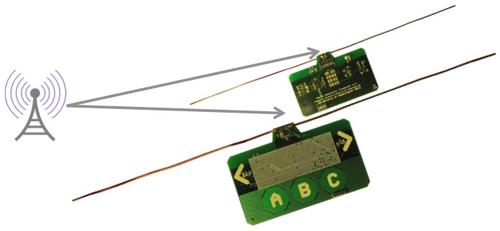Engineers Design Battery-Free Wireless Device
November 11, 2013

Since the onset of television, radio, and WiFi, we have been inundated with a vast array of RF signals, which allow us to listen to music, watch television, and stay connected to one another with our mobile devices.
Recently, Nickolay Lamm and colleague Dr. M. Browning Vogel were able to visualize the various signal patterns that make up WiFi transmissions and illustrate those using rather striking colors. Suffice it to say they are everywhere, covering just about every square foot of space in populated cities, and thanks to some ingenious engineers, can be utilized to provide another service besides communications and artwork. Those engineers, from the University of Washington, have developed a way to harness those signals to power communications devices without the need for batteries or other power sources.

Known as Ambient Backscatter, the device (or any device equipped with the technology) is equipped with an antenna that picks up broadcast signals from TV or cellular sources and converts them into hundreds of microwatts of electrical power. The device uses the newly acquired power to modify the signal taken and then transmits that signal with embedded code back to the source. Other devices outfitted with the technology can then receive the coded messages and respond accordingly, which is necessary if the Internet of Things (IoT) is to become mainstream.
The engineering team constructed the device using an antenna connected to a PCB board the size of a credit card. The cards were then outfitted with a single LED that lights up when the card receives a signal without an onboard or external power source.
In tests, the engineers found that two cards positioned only a few feet away could communicate with one another using a transmission source positioned over six miles away. The power conversion, however, was only sufficient to relay sensor information or text messages, which is still impressive.
The technology opens the door to a host of near future possibilities that could benefit from ambient backscatter transmissions, including embedding sensors into hard-to-reach areas where power is an issue, such as concrete or inside walls and other structures. As long as the device is able to acquire a signal they could be implemented everywhere.
When the Ambient Backscatter device puts itself into "hibernation mode," it will only take advantage of RF signals, which it stores on a capacitor, until it has enough power to complete the function desired. Mobile users, for instance, would still be able to send and receive text messages even though their devices are no longer charged. The possibilities are vast when it comes to device implementation, but the technology is still in its infancy. However, it's only a matter of time before it will be refined enough to be able to be used for more than text messages and sensor data.
Related posts:
About the Author(s)
You May Also Like





